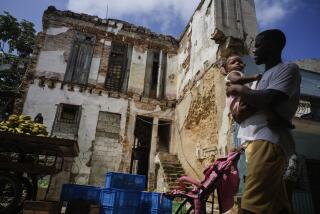Squatters Being Relocated : Old Havana Gets a Face Lift for Tourists
- Share via
HAVANA — In hopes of attacting more tourist dollars, the Cuban government is changing the face of Old Havana, a 2 1/2-square-mile area of decaying and overcrowded historic buildings.
Tourism is now bringing $100 million a year to the Caribbean island nation. Hotels previously used by the armed forces are being given to Cuba’s Tourism Institute.
Old Havana’s foundation dates to 1519 and to colonization by Spain.
Its small main plaza is surrounded by a fortress and the old Home of the Captain Generals. They are colonial constructions of baroque architecture with Moorish-like patios with the traditional aljibe , or tile-covered water well.
Groups of European tourists troop through museums and plazas in the restored area where streets are still being dug up to replace cobblestones. Most of the area is now a pedestrian zone.
But in a city where housing is a serious problem, the buildings had been taken over by squatter families even before the revolution that brought President Fidel Castro to power in 1959.
Leandro Romero, a researcher for the National Musuem, one of the organizations working on the restoration, said many of the families, some of whom live in single rooms, will have to be relocated so that those who stay can have a livable space.
A building’s facade near the main plaza has been repainted white and blue. The structurehouses three families. “Those who live in the buildings are given the option to buy the home,” Romero said.
Buying a home is a new concept in Castro’s Cuba, permitted by a law passed only recently.
Live-in owners keep their houses in better condition, Romero said as he pointed to the many flower pots and hanging plants on the balconies.
A four-story building that used to house a girls’ school in the pre-revolutionary days later became a tenement where 16 families lived. It is now almost restored, and only four families live there.
The restoration includes touches from Spain’s colonial days in the Caribbean. The place where the first barber shop was set up has been restored. It is again a barber shop with the official diploma of the original barber on the wall.
There is also a replica of the first pharmacy.
Many of the buildings are being turned into museums or cultural exhibits of countries friendly to Cuba.
The restoration, Romero said, is financed by the Cuban government and is in its second five-year plan. Forty-one buildings have been restored.
“It is difficult,” said Romero pointing to the country’s economic problems. “There are times when something is delayed because we lack simple things like nails or paint. But we all love Old Havana.
“We want to give a new sense to the old part of Havana. We do not want a Hollywood-type appearance, but a city that lives in accord with its inhabitants.
“And we want tourism, but we do want good tourism. We do not want the tourist that brings drugs.”
The Cuban government is doing other things to increse tourism on the island. Jesus Jimenez Escobar, vice president of the Tourism Institute, said 206,000 tourists came to Cuba in 1984 and that the figure is expected to increase by 25% this year. Of those who came last year, 168,000 were from Western countries, mainly Canada, Italy, Mexico and Spain.
The government is planning to build 5,000 hotel rooms in the next two to five years and is making agreements with Spanish companies to train personnel in the tourism industry and improve services.
More to Read
Sign up for Essential California
The most important California stories and recommendations in your inbox every morning.
You may occasionally receive promotional content from the Los Angeles Times.













